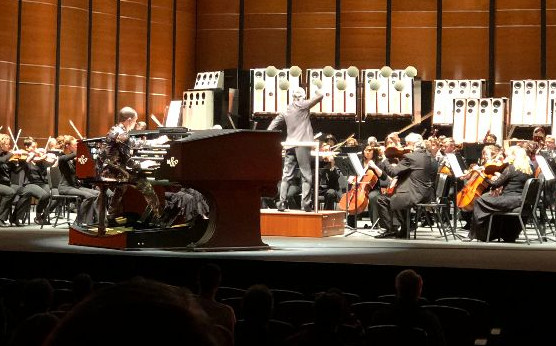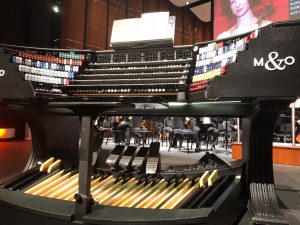 Not since Virgil Fox has a concert organist so captured the public imagination as Cameron Carpenter. His latest album, All You Need is Bach, reached no. 1 on the Billboard Classical charts in the US and Europe.
Not since Virgil Fox has a concert organist so captured the public imagination as Cameron Carpenter. His latest album, All You Need is Bach, reached no. 1 on the Billboard Classical charts in the US and Europe.
He brought flair to the Austin Symphony concert held at the Long Center on March 22 in two main selections and two encores.
Wanamaker’s department store in Philadelphia commissioned a work from the Belgian Joseph Jongen to inaugurate the giant organ it had placed in its atrium in 1911. The performance was scheduled for 1928 but never happened as the store owner died. It was this Symphonie concertante that served as a showcase for Carpenter’s talents in the first half of the Austin concert. His instrument of choice is a unique artistic digital organ (pictured here) that took him 10 years to create, allowing the sound of historical organs to be heard in any concert setting around the world.
The first movement by Jongen begins with a fugue. It transitions from sounding like a penny arcade to a sweeping score for a Hollywood drama of the 1930s, although it ends in quite a placid manner. The contrast with the second movement is stark, as it has a highly comical opening that transitions to a faux religious sound.
A solo flute begins the third movement with a charming and inquiring tune. It is answered by the strings with a tender melody of sublime pathos. Throughout, the organ stays very much in the background, but once it gets involved the pathos becomes a full-on psycho drama with the wind instruments egging the organ along. The movement then enters a dream-like sequence where the violins create a plane of consciousness for the organ to float over. Quite delightful! A brief fourth movement is all fire and fury, allowing both the Symphony and Cameron to literally let out all the stops.
 Overall the Symphonie concertante eschews the bombastic in favour of the whimsical picturesque, allowing the organ to explore its range; a measure of its success was a rousing standing ovation which Cameron followed by the Overture to Leonard Bernstein’s Candide. A technically complex piece, it showed even better than the Jongen piece why the organ is truly a 4-limb instrument. Patrons leaving for the intermission were exclaiming “wow” and “that was really something!”
Overall the Symphonie concertante eschews the bombastic in favour of the whimsical picturesque, allowing the organ to explore its range; a measure of its success was a rousing standing ovation which Cameron followed by the Overture to Leonard Bernstein’s Candide. A technically complex piece, it showed even better than the Jongen piece why the organ is truly a 4-limb instrument. Patrons leaving for the intermission were exclaiming “wow” and “that was really something!”
The second offering of the concert was primarily for the Symphony, as the organ had relatively little to do. This was Symphony No. 3 by Saint-Saens, from 1886. While the organ is silent the Symphony builds a dramatic landscape of depth and intensity. The organ tentatively enters, seemingly aware of the landmines that pepper the vista before it.
After a second lengthy orchestral phase, the organ makes its presence known in such a loud and unanticipated way that some people jumped in their seats. Presumably it set off one of those landmines; I suspect the composer did it to make sure everyone in the audience was roused from any slumbers. The concluding fugue is capped by a grandiose finale that brought the Austin audience to its feet.
This captivating concert will be performed again tonight, March 23, 2018.
Visit the website for details: austinsymphony.org
Photos with this article copyright by C. Cunningham, Sun News Austin
Lead photo shows conductor Peter Bay, with baton held high, and Mr. Cameron playing the digital organ
Second photo shows a close-up of the digital organ.